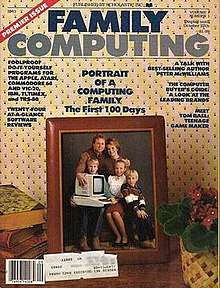Family Computing
Family Computing was a U.S. computer magazine published during the 1980s by Scholastic, Inc.. It covered all the major home computer platforms of the day including the Apple II, Commodore VIC-20 and 64, Atari 8-bit family as well as the IBM PC and Macintosh. It printed a mixture of product reviews, how-to articles and type-in programs. The magazine also featured a teen-oriented insert called K-Power, written by Stuyvesant High School students called the Special-K's. The section was named after a former sister magazine which folded after a short run. This section was discontinued after the July 1987 issue as part of the magazine's shift toward home-office computing.
 Volume no. 1, Issue no. 1, September 1983 | |
| Editor-in-chief | Claudia Cohl |
|---|---|
| Frequency | Monthly[1] |
| Circulation | 420,000 (1986-08-08)[2] |
| Publisher | Scholastic, Inc.[3][4] |
| First issue | September 1983 |
| Final issue | April 2001[5] |
| Country | United States |
| Based in | New York City |
| Language | English |
| Website | www.destinationsoho.com (Historical) Archived October 17, 2000, at the Wayback Machine |
| ISSN | 0899-7373 |
History and profile
The first issue of the magazine appeared in September 1983.[6] It was notable in the early days for the wide variety of systems it supported with type in programs, including such "orphaned" systems as the Coleco Adam and TI 99/4A long after other magazines discontinued coverage. There was also a spinoff TV show on Lifetime hosted by Larry Sturholm,[7] of which at least 26 episodes were produced.[8]
Another section of the magazine was contributed by Joey Latimer and dealt with music related themes.[9][10] This mostly amounted to BASIC program listings that would play some sort of tune on the computer platforms covered by the magazine.
After the video game crash of 1983 the magazine began to change its focus toward the burgeoning home office movement of the late 1980s and early 1990s, initiating coverage of non-computing products such as fax machines and office furniture. Article topics began to include ideas for starting a home-based business and time management tips. The title was changed, first to Family & Home Office Computing[11] and finally to just Home Office Computing[12] with ever-diminishing coverage of family computing topics.
In January 1998 Scholastic sold the title to Freedom Technology Media Group,[13] which published the magazine until the April, 2001 issue.[5]
References
- CHILDREN'S MAGAZINES FOR A COMPUTER AGE, By GLENN COLLINS, Published: September 10, 1983, NYTimes.com, Our magazine is primarily for parents, said Claudia Cohl, editor of Family Computing. Its 110 pages make it the heftiest of the new publications; the first issue of the magazine, published by Scholastic Inc., has just reached the stands. ... Family Computing , 730 Broadway, New York, N.Y. 10003; $17.97 for 12 issues a year.
- Burroughs Down To Agency Finalists, August 08, 1986, By George Lazarus, Chicago Tribune, Scholastic Inc.`s Family Computing magazine celebrates its third anniversary with its September issue, but the ``real celebration`` ought to be with its October issue. The magazine, which has more than doubled circulation since its start-up to 420,000, will be running its first ad ever from General Motors Corp. on the back cover of its October issue. This is a corporate ad placed by N.W. Ayer, which has the corporate account.
- "There were 128 computer magazines being published in 1983," said Shirred Rhoades, who helped launch Family Computing for Scholastic,Inc.,... He said , "Dick Robinson, the chairman of Scholastic, went to a consumer electronics show, and he saw this new thing called a personal computer...So we launched Family Computing. Page 179, The Magazine Century: American Magazines Since 1900, By David E. Sumner
- Scholastic Magazine to Go Private, October 23, 1986, LISA A. LAPIN, Los Angeles Times, The company also publishes Family Computing magazine, which has 410,000 subscribers.
- "FTMG Closes Home Office Computing; Launches DestinationSoho".
- "Premier Issue". Family Computing. Retrieved December 26, 2015.
- Apparel Design Software 1984, I got a lot of press at the time for designing clothes using a computer, and was interviewed for a segment on a TV show called FAMILY COMPUTING., Lifetime, Family Computing, No. 423, 28.06, MTI Studios, Perlmutter,INc./Scholastic,Inc. 1984-12-12
- "CHILDREN'S BOOKS COMPANY MAKES TV MARK" Stephen Farber, The New York Times, January 21, 1985
- "Joey Latimer Archives". Archived from the original on 2015-02-14. Retrieved 2015-04-08.
- Joey Latimer History, In 1983 I was one of the founding editors of Family Computing Magazine and K-Power for Scholastic, Inc. My game, music, and utility programs were featured in The Programmer section of Family Computing.
- Magazine Gets A Name Change, October 09, 1987, Chicago Tribune, Family Computing magazine changed its name to Family & Home-Office Computing with the October issue. An ``Editor`s Note`` from editor-in-chief Claudia Cohl says the new name ``reflects the editorial direction of our magazine for the past year or two.`` The magazine is 4 years old.
- Magazines: A Complete Guide to the Industry, By David E. Sumner, Shirrel Rhoades, Page 9, Scholastic used positioning gurus Jack Trout and Al Reis to help plot a step-by-step transition from Family Computing to Family & Home Office Computing to finally simply Home Office Computing. This editorial adjustment followed a shifting marketplace.
- "Freedom Technology Media Group to Shut Down Home Office Computing; Title Geared to Home Office Workers Will Cease Publication With April Issue".